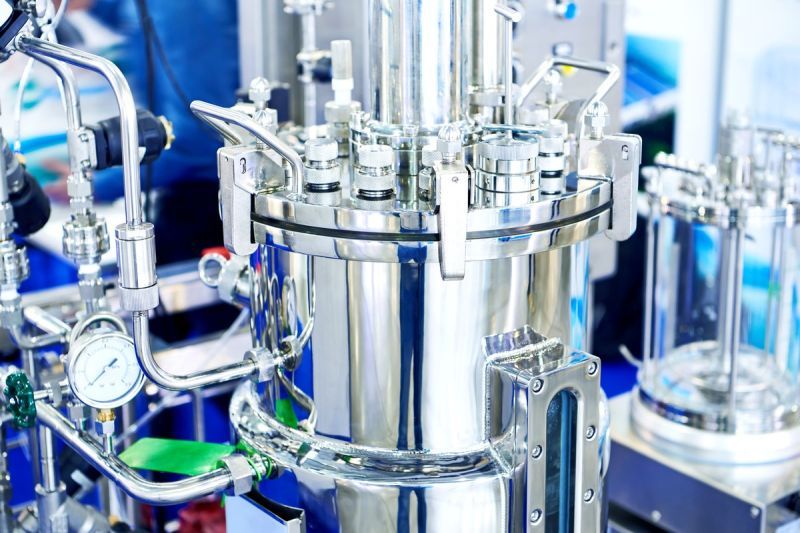Ingredients for the Future: Bringing the Biotech Revolution to Food

New biological technologies are sweeping across industries and unlocking possibilities for food.1 Fermentation, a type of bioprocessing, allows food producers to make proteins and other ingredients using microbes rather than animals, significantly reducing land use and emissions from animal agriculture while increasing reliability and food security.
Fermented novel proteins could make up about 4 percent of total protein production by 2050, an annual market of $100 billion to $150 billion, with variability based on climate policies and the pace of technological development. Advancements in fermentation technology also stand to benefit other industries such as chemicals and materials.
Before novel proteins can take off, fermentation technology will need to scale. Most novel-ingredients players today have production costs that are an order of magnitude higher than the cost of the production of traditional protein, which are typically in the range of $2 to $15 per kilogram. To bring down price points through economies of scale, our projections show fermented-novel-ingredients players will need to invest more than approximately $250 billion cumulatively by 2050 to expand capacity.
In this article, we explore how the food industry can accelerate the shift to fermentation-derived ingredients, most notably proteins. To get there, incumbents, start-ups, and investors can improve fermentation production processes and bioreactor technology to reduce costs, make new products that are compelling to consumers, and bring partners together to scale the industry.
The potential for novel ingredientsThe potential market for fermented-protein products is expected to be $100 billion to $150 billion by 2050 (Exhibit 1). This opportunity has spurred traditional-fermentation players, food giants, sovereign wealth funds, and others to invest more than $4 billion of capital in precision and biomass fermentation over the past five years.
Exhibit 1
The high interest in novel foods is due to their ability to augment traditional food production. For proteins in particular, the global market today is sizable, at approximately $3.0 trillion, and is estimated to grow to approximately $3.5 trillion by 2050. However, increasing feed prices, climate volatility, and disease are challenging animal agriculture’s ability to support the nutrition needs of the growing global population.
Novel ingredients produced through bioprocessing are a way to mitigate these risks (see sidebar “About fermentation and cultivation of cell cultures”). Because fermentation takes place in a synthetic environment (bioreactors), manufacturing is both controlled and modular, increasing geographic flexibility and reducing exposure to weather, supply chain, and disease-related disruptions in the traditional food and agriculture value chain. In addition, fermentation requires a smaller land footprint than traditional agriculture, making it a powerful option for building greater food security.
Manufacturing is both controlled and modular, increasing geographic flexibility and reducing exposure to weather, supply chain, and disease-related disruptions in the traditional food and agriculture value chain.
Scale drivers for the future of foodBefore the novel-ingredients industry can help make food systems more sustainable and resilient, it needs to be scaled up significantly. However, existing capacity to support scale-up is limited, and contract manufacturing organizations (CMOs) often have margin expectations that are not in line with food manufacturing industry standards, often making them unviable for companies looking for more capacity. Although several new capacity additions have been announced, others have fallen by the wayside due to macroeconomic factors.
Building more capacity isn’t the only challenge. The underlying technology and processes need to be developed and improved. The opportunities and risks of novel ingredients are still being investigated, and incumbents, start-ups, and investors alike are in the process of allocating capital expenditures, keeping stock of new developments, and understanding customer needs.
To demystify the future of this growing industry, we identified three areas crucial to building and scaling a new food ecosystem:
- Process improvements and redesigned bioreactors could drive yield improvements, reduce bioreactor costs, and lower production costs by approximately 50 percent; new bioreactor technology could also expand the global market opportunity for OEMs.
- Upgraded formulation and food design could result in a wider variety of high-quality offerings, particularly as companies improve product taste and texture.
- New business models could help the industry mitigate risks and finance more than $250 billion in expected infrastructure scale-up.
The single most important factor for launching the novel-food market will be reducing the unit costs of novel ingredients. By implementing technological innovations in bioprocessing and downstream production processes—taking a total cost-of-goods-sold (COGS) approach—novel-ingredient companies could have line of sight to cost reductions of approximately 50 percent right now (Exhibit 2).
Exhibit 2
Most savings are expected to come from primary drivers of the COGS, including titer (the measure of concentration of the desired product in the post-fermentation broth), downstream processing (converting the fermentation broth into a stable product), and cycle time.
Some of these drivers have steadily improved over time. For example, core intellectual property (IP) owners are making continuous titer improvements, and for decades, chemical and pharmaceutical companies have deployed digital analytics and, increasingly, AI to optimize manufacturing.
What could truly spur the industry forward is step-change process improvements. More-fundamental changes to bioprocessing could significantly increase active cycle time and capital efficiency. Several start-ups are exploring converting fed-batch processes into continuous ones (see sidebar “Case study: Australian bioprocessing start-up Cauldron”), while other companies are converting traditional aerobic processes into anaerobic ones.
)
)
)
)

